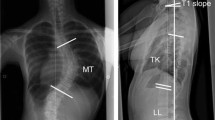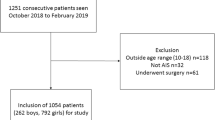Abstract
Purpose
Alignment of the cervical spine (CS) in adolescent idiopathic scoliosis (IS) as well as in asymptomatic adult populations has recently been studied and described as being less lordotic in the adolescent IS population. However, few studies have examined the sagittal alignment of the CS in adult IS or its association with other radiological variables and clinical relevance. The aim of this study is to analyse the sagittal alignment of CS in adult IS and its association with age, alignment of the thoracic, lumbar and global spinal column as well as health-related quality of life (HRQOL) parameters.
Methods
A retrospective review of prospectively collected data from a multicenter database was performed. Of 468 consecutive adult IS patients, 213 were included in the study; the remainder were excluded due to poor quality X-rays where the CS was not properly visible, or previous surgery. X-rays were measured for the following CS parameters: [Cranial base-C2 (C0–C2) lordosis, C2–C7 lordosis, thoracic (T1) slope, thoracic inlet angle (TIA) and odontoid (Od)-T1 offset using a measurement software]. These measurements were then evaluated for possible associations with patient age and with pre-existing alignment parameters and HRQOL scores using Pearson correlation tests.
Results
The average and standard deviations for CS alignment parameters were 32.3° ± 10.2° for C0–C2; 5.7° ± 14.1° for C2–C7; 23.9° ± 11.3° for T1 slope, 70.5° ± 14.7° for TIA and 20.8° ± 16.5° for Od-T1 offset. CS alignment showed a significant (p < 0.05) correlation with age, T kyphosis and several other sagittal alignment parameters such as sagittal vertical axis (SVA), global tilt and T1 sagittal tilt, but not with the HRQOL parameters.
Conclusion
The sagittal alignment of the CS in adult IS is less lordotic than the normal average while less kyphotic than that of IS of a younger age. It correlates with age, thoracic kyphosis and some global sagittal alignment parameters. These findings suggest that CS alignment is likely a component of the global sagittal alignment strongly affected by thoracic kyphosis, and most probably does not affect HRQOL by itself.
Similar content being viewed by others
References
Roussouly P, Labelle H, Rouissi J, Bodin A (2013) Pre- and post-operative sagittal balance in idiopathic scoliosis: a comparison over the ages of two cohorts of 132 adolescents and 52 adults. Eur Spine J 22(Suppl 2):S203–S215. doi:10.1007/s00586-012-2571-x
Blondel B, Schwab F, Ames CP, LeHuec JC, Smith JS, Demakakos J (2012) The crucial role of cervical alignment in regulating sagittal spino-pelvic alignment in human standing posture. In: 19th international meeting on advanced spine techniques. Istanbul, Turkey
Smith JS, Shaffrey CI, Lafage V, Blondel B, Schwab F, Hostin R, Hart R, O’Shaughnessy B, Bess S, Hu SS, Deviren V, Ames CP (2012) Spontaneous improvement of cervical alignment after correction of global sagittal balance following pedicle subtraction osteotomy. J Neurosurg Spine 17:300–307. doi:10.3171/2012.6.SPINE1250
Scheer JK, Tang JA, Smith JS, Acosta FL Jr, Protopsaltis TS, Blondel B, Bess S, Shaffrey CI, Deviren V, Lafage V, Schwab F, Ames CP (2013) Cervical spine alignment, sagittal deformity, and clinical implications: a review. J Neurosurg Spine 19:141–159. doi:10.3171/2013.4.SPINE12838
Yu M, Silvestre C, Mouton T, Rachkidi R, Zeng L, Roussouly P (2013) Analysis of the cervical spine sagittal alignment in young idiopathic scoliosis: a morphological classification of 120 cases. Eur Spine J 22:2372–2381. doi:10.1007/s00586-013-2753-1
Glassman SD, Berven S, Bridwell K, Horton W, Dimar JR (2005) Correlation of radiographic parameters and clinical symptoms in adult scoliosis. Spine (Phila Pa 1976) 30:682–688 (pii:00007632-200503150-00016)
Glassman SD, Bridwell K, Dimar JR, Horton W, Berven S, Schwab F (2005) The impact of positive sagittal balance in adult spinal deformity. Spine (Phila Pa 1976) 30:2024–2029 (pii:00007632-200509150-00005)
Villavicencio AT, Babuska JM, Ashton A, Busch E, Roeca C, Nelson EL, Mason A, Burneikiene S (2011) Prospective, randomized, double-blind clinical study evaluating the correlation of clinical outcomes and cervical sagittal alignment. Neurosurgery 68:1309–1316. doi:10.1227/NEU.0b013e31820b51f3 (discussion 1316)
Tang JA, Scheer JK, Smith JS, Deviren V, Bess S, Hart RA, Lafage V, Shaffrey CI, Schwab F, Ames CP (2012) The impact of standing regional cervical sagittal alignment on outcomes in posterior cervical fusion surgery. Neurosurgery 71:662–669. doi:10.1227/NEU.0b013e31826100c9 (discussion 669)
Ames CP, Blondel B, Scheer JK, Schwab FJ, Le Huec JC, Massicotte EM, Patel AA, Traynelis VC, Kim HJ, Shaffrey CI, Smith JS, Lafage V (2013) Cervical radiographical alignment: comprehensive assessment techniques and potential importance in cervical myelopathy. Spine (Phila Pa 1976) 38:S149–S160. doi:10.1097/BRS.0b013e3182a7f449
Boissière L, Obeid I, Vital J-M, Kleinstück F, Pellisé F, Perez-Grueso FJS, Alanay A, Acaroglu E, ESSG (2014) Global tilt: a single parameter incorporating the spinal and pelvic sagittal parameters and least affected by patient positioning. Eur Spine J 23(Suppl 5):S483–S484
Pellisé F, Domingo-Sabat M, Alanay A, Bagó J, Vila-Casademunt A, Villanueva C, Acaroglu E, ESSG (2012) Impact of radiographic parameters on HRQOL in adult spinal deformity. The “Lordosis Gap” better than lumbar lordosis? Eur Spine J 21:S269–S337
IBM Corp. (2012) IBM SPSS statistics for windows V21.0. In: IBM Corp., Armonk, NY
Acknowledgments
This project has been funded by a research grant from Depuy Spine Inc. directed to the European Spine Study Group.
Conflict of interest
Bilal Aykac, M.D.: Stryker Spine, Grants/Research Support; Selim Ayhan, M.D.: Stryker Spine, Grants/Research Support; Selcen Yuksel, Ph.D.: None; Umit Ozgur Guler, M.D.: None; Ferran Pellise, M.D., Ph.D.: Biomet Spine, Consultant, DePuy Synthes Spine, Grants/Research Support, Consultant, K2M, Grants/Research Support; Ahmet Alanay, M.D.: DePuy Synthes Spine, Grants/Research Support, Consultant; Francisco J Sanchez Perez-Grueso, M.D.: DePuy Synthes Spine, Grants/Research Support, Consultant, K2M, Grants/Research Support; Emre Acaroglu, M.D.: AOSpine Europe, Education (Ortho) Officer, Biomet Spine, Speaker’s Bureau, Cotrel Foundation, Grants/Research Support, DePuy Synthes Spine, Grants/Research Support, IncredX, Stockholder, Medtronic, Consultant, Stryker Spine, Grants/Research Support
Author information
Authors and Affiliations
Consortia
Corresponding author
Rights and permissions
About this article
Cite this article
Aykac, B., Ayhan, S., Yuksel, S. et al. Sagittal alignment of cervical spine in adult idiopathic scoliosis. Eur Spine J 24, 1175–1182 (2015). https://doi.org/10.1007/s00586-015-3868-3
Received:
Revised:
Accepted:
Published:
Issue Date:
DOI: https://doi.org/10.1007/s00586-015-3868-3




